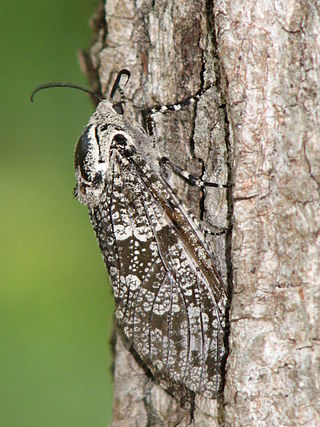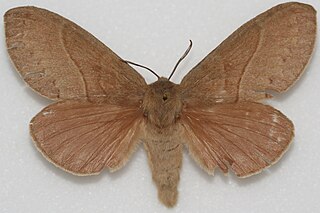
The Cossinae are the nominate subfamily of the Cossidae. The caterpillars of several Cossinae species, such as the carpenterworm and the goat moth, are significant pests. On the other hand, in Chile the caterpillars of the Chilean moth are collected on a commercial scale for sale as fishing bait and terrarium pet food; they are usually called "butterworms" in international trade.
Rindgea is a genus of moths in the family Geometridae described by Alexander Douglas Campbell Ferguson in 2008.

Idia is a genus of litter moths of the family Erebidae first described by Jacob Hübner in 1813.

Cryphia is a genus of moths of the family Noctuidae. The genus was erected by Jacob Hübner in 1818.

Grotella is a genus of moths of the family Noctuidae first described by Leon F. Harvey in 1875.

Homorthodes is a genus of moths of the family Noctuidae.
Redingtonia is a monotypic moth genus of the family Noctuidae. Its only species, Redingtonia alba, is found in the US state of Arizona. Both the genus and species were first described by William Barnes and James Halliday McDunnough in 1912.
Caloecia is a genus of moths in the family Lasiocampidae. The genus was erected by William Barnes and James Halliday McDunnough in 1911. Both species are known from the US state of Arizona.

Dicogaster is a genus of moths in the family Lasiocampidae first described by William Barnes and James Halliday McDunnough in 1911. Its only species, Dicogaster coronada, was first described by Barnes in 1904. It is found in Arizona.
Hymenodria is a monotypic moth genus in the family Geometridae erected by James Halliday McDunnough in 1954. Its only species, Hymenodria mediodentata, was first described by William Barnes and McDunnough in 1911. It is found in North America.
Schinia carolinensis is a moth of the family Noctuidae first described by William Barnes and James Halliday McDunnough in 1911. It is found in the United States from eastern North Carolina to the Florida peninsula and probably along the Gulf Coast.

Idia diminuendis, the orange-spotted idia, is a litter moth of the family Erebidae. The species was first described by William Barnes and James Halliday McDunnough in 1918. It is found in North America from Wisconsin to Nova Scotia, south to Florida and Texas.
Idia julia, or Julia's idia, is a litter moth of the family Erebidae. The species was first described by William Barnes and James Halliday McDunnough in 1918. It is found from southern Canada south to Georgia and Texas.
Idia terrebralis is a species of litter moth of the family Erebidae first described by William Barnes and James Halliday McDunnough in 1912. It is found in North America, including Illinois.
Ursia is a genus of moths of the family Notodontidae, the prominents. The genus was erected by William Barnes and James Halliday McDunnough in 1911.
Alpheioides is a genus of snout moths. It was described by William Barnes and James Halliday McDunnough in 1912, and contains the species Alpheioides parvulalis. It is found in North America, including southern California, Arizona and Oklahoma.
Anemosella viridalis is a species of snout moth in the genus Anemosella. It was described by William Barnes and James Halliday McDunnough in 1912, and is known from Mexico and the US state of Arizona.
Negalasa is a monotypic snout moth genus. Its one species, Negalasa fumalis, is found in the US state of Arizona. Both the genus and species were described by William Barnes and James Halliday McDunnough in 1913 in the same paper.
Agylla septentrionalis is a moth of the family Erebidae. It was described by William Barnes and James Halliday McDunnough in 1911. It is found in North America, including Arizona and South Carolina.
Givira is a genus of moths in the family Cossidae.






